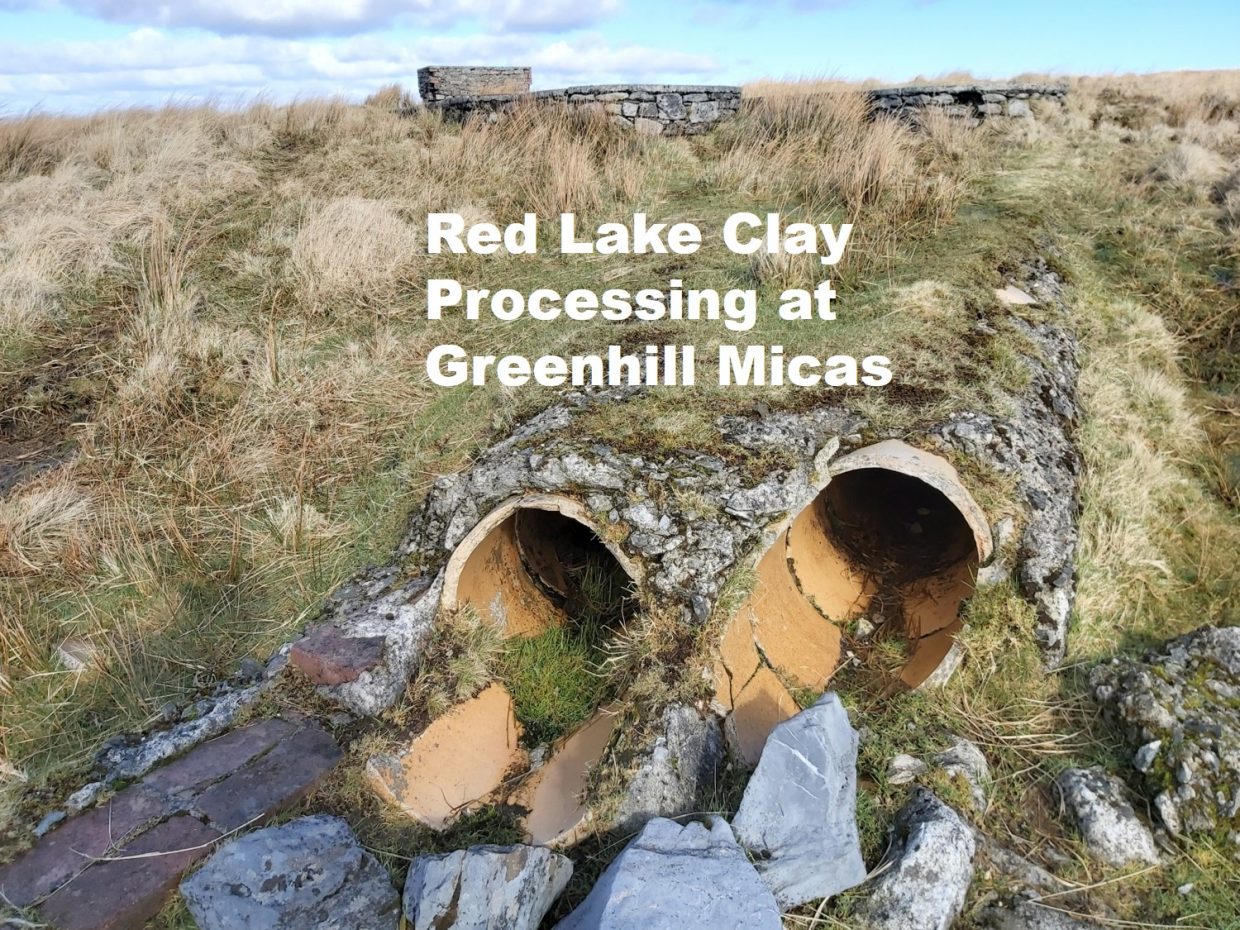This post relates to the Greenhill Micas, Quickbeam Quarry and the Explosive Magazine parts of the Red Lake China Clay Works. Due Reference is made to the excellent EA Wade publications (1982 and 2004).
If you ever are on the main walking routes in this area, namely; Abbots Way, Zeal Tor Tramway or the Red Lake tramway around Browns Heath, much of this first stage filtering processing complex of the clay might be easily missed as its hidden from view. It is well worth “following the process” from East to West, starting at Crossways.


This is an overlay of the plan by EA (Ted) Wade on the OS Map, which I created to assist with the exploration. Greenhill Mica complex is at around 460m asl, whereas the clay operation is at around 445m asl. The hill where the complex is would have been an ideal place to start the “gravity” fed pipeline to Cantrell some 8 miles away, rather than closer to Red Lake.
It is noted by Colin Yelland from Dartmoor 365 facebook site that: “Ted Wade’s position for the explosive magazine came from the plan included in the 1920 auction catalogue. In fact, the map on page 52 of the first edition of his book is almost an exact copy of the auction catalogue plan.” We agree that the original plan of the site has not correctly recorded the explosive’s magazine location.

The Explosive Magazine, looking East towards Avon Valley and Heap of Sinners. Unfortunately, the location appears incorrect in Wade’s books as its South of the Abbots Way, not North of it.

Another view of the Explosive Magazine in relation to the sky tip at Red Lake which can be seen in the distance. SX65176 65915

Inside the Explosive Magazine. Some GWR bricks lying around still. The windows are bricked up but designed to allow fresh air to circulate into the structure. Explosives would have been used to blast any un-kaolinised granite that existed in the pit which was in the way of china clay extraction

Some kind of loading platform between the Explosive Magazine and Quickbeam Quarry. Not mentioned in the Wade book.

Quickbeam Quarry. Was this used to get stone for the building of the micas and concentrators?

Quickbeam Quarry. SX65059 65826

Tumbling Bay, where the liquid clay was pumped via a 15 inch steel rising main. SX65047 65759. This was the start of the initial processing stage

Tumbling Bay, the start of extraction process.

The hole, most likely where the pipe was fed into the Tumbling Bay.

The exit point on the Tumbling Bay, where two pipes feed the next part of the process, the sand bays.

Next stage, the sand pits. You can see the Tumbling Bay in the centre / top of the picture. SX65044 65746

Another view of the sand Pits, looking west. One assumes this process removed the fine sand found in the clay slurry.

The entry point into one if the Sand Pits from the Tumbling Bay.

The exit pipes from the sand Pits, feeding into the micas.

The Micas. You can see the inlet pipes, sand pits and Tumbling Bay in this picture.

Wade states these micas were 335 feet long by 43 feet wide. SX65019 65728

One of a number of inspection holes next to the micas. This one at SX65023 65667.

Exit pipe from the micas, heading to the concentrators…….

The pipe from the micas heading towards a small concrete construction which fed the concentrators.

The small concrete construction feeding the concentrators at SX65008 65613

The concentrators no. 1 complex. Four huge square brick, stone and concrete bays, stated by Wade as being 38 feet square by 13 feet deep.

Frank Collinson shows the scale of the Concentrators no. 1. Each section seemed to have evidence of a concrete floor sloping inwards to the centre.

Each of the four concentrators had a metal rod in the centre. Was this some kind of agitation action ?

Frank Collinson in the centre of Concentrators no. 1 complex at SX64988 65619

Now onto Concentrators no. 2 complex. Wade states each section is 52 feet square by 12 feet 6 inches deep at the centre outlet. The Erme valley can be seen in the distance. SX64918 65596.

There are three types of bricks to be found GWR and these: CANDY and Hexter Humpherson.

One flooded section of Concentrators no 2. Note the sluice gate on the left.

More sluice gates in the concentrators no. 2 complex.

The final stage, mica concentrators. According to the plan, these appear to have been fed by both the micas and the concentrators no.2. SX64933 65490

Valve at the centre of mica concentrators.

Start of the gravity fed pipeline, below the mica concentrators. The picture shows inspection cover / hole no. 1. This is the first of the 80 inspection points down the pipeline all the way to Cantrell. SX64948 65454

The second inspection point on the pipeline. SX64995 65387

Stone built platform at 6 miles, 70 chains from the locomotive shed near Western Beacon. SX64884 65503. Wade states that this platform was built to serve Greenhill micas and is 108 feet long and 2 foot, 8 inches high.

Start of the return leat (see darkish line in photograph), back to Red Lake. This was to recycle water which was a precious commodity needed to operate the “monitors”, which were used to extract the clay in the clay pit.

Red Lake Cottage. SX64720 65941. Home of captain and Mrs Bray. 7 miles and 50 chains.

Red Lake Cottage with view to Red Lake Sky tip. Mrs Bray ran the hostel at the main Red Lake complex.
The above article was written by the author as one of a 5 part series for Dartmoor News

1 Pingback